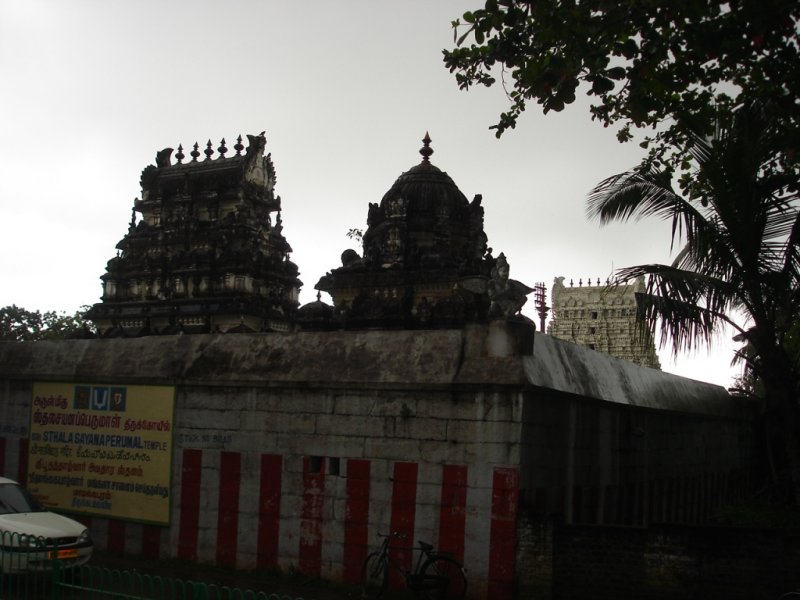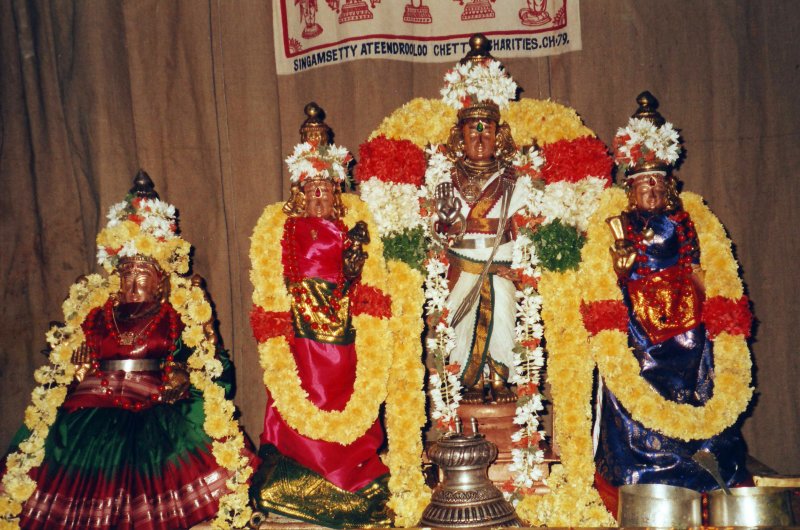GITA 11.55
In the last few slokas, the greatness of Bhakti was explained. The Lord told Arjuna that to realize Him, to see Him and to reach Him, Bhakti was the only media. With that, the 11th Chapter ended. Before we go to Chapter 12, we will see the greatness of Chapter 11, as queried by Sri Parvati to lord Shiva. Lord Shiva replies that there lived a bhakta by name Sunanda. He lived in a place on the banks of river Praneetha, in North India. He used to daily study with reverence Chapter 11 of Gita.
Once he went on a pilgrimage to many places. In one place he requested many people to give him some place to rest. None was willing to give. Finally, one person allowed him to sleep on a raised platform outside his house. Sunanda slept that night there and in the morning the person who gave place to sleep for Sunanda was surprised but he did not reveal the reason for his surprise. He suggested to Sunanda to spend more days in that place and use the same place for his rest. Sunanda agreed and spent some days in that place.
After a few days, the person asked Sunanda to sleep in his house. For a day, no one slept on the raised platform outside his house. But the next day, that person came running to Sunanda and cried that his son was killed and eaten by a Rakshasa in the night. Sunanda asked for details. The person then told that there was a custom in that town. A Rakshasa was killing people and eating them. The people of the town requested the Rakshasa that he should not kill indiscriminately and that they would arrange for a person daily and the person would be sleeping on the raised platform for the Rakshasa to eat. The Rakshasa agreed and the people of the town used to make a traveller to sleep on the raised platform and the Rakshasa would eat. A few days back when Sunanda wanted a place to rest, all others refused and this person, as usual, gave the raised platform as the place to rest for Sunanda.
When in the next day, Sunanda was alive the next morning this person was surprised and that is why he requested Sunanda to stay for some more days. Later, he changed Sunanda's place for resting and left the raised platform vacant. That night the Rakshasa complained and demanded a human being for eating. Next day this person asked his son to fetch a traveller. The son was not aware of the Rakshasa and so after fetching a traveller, he also slept along with the traveller on the raised platform and the Rakshasa ate both of them. In the morning when the person discovered that his son was eaten, he went to the Rakshasa and demanded his son to be returned alive. But the Rakshasa declined and so the person asked the remedy to get back his son. At that time the Rakshasa told that when Sunanda was sleeping, because of his study of Chapter 11, the Rakshasa could not go near him. So now the person should request Sunanda to do Parayana (devoted study) of Chapter 11 and afterwards, Sunanda should sprinkle water on the Rakshasa, when the Rakshasa would redeem his earlier form and at the same time the person's son and the traveller, who were eaten by the Rakshasa also would get back to life. Sunanda agreed to the request of the person and after Parayana of Chapter 11, sprinkled water on the Rakshasa who immediately got back to his earlier form. The Rakshasa did not try to help a Brahmin who was being eaten by a vulture and so he was cursed to become a Rakshasa and now he not only got back his earlier form but attained Mukti (liberation) also. The person's son also got back his life. Thus the Chapter 11 is capable of getting Mukti.
The 11th Chapter which details the Lord's Viswaroopam is thus very great. Everyone should perform Parayana of Chapter 11. In fact in the story told by lord Shiva, the son of the person refused to accompany his father as he said that after knowing the greatness of Chapter 11, he would thenceforth perform Parayana and advised his father also to do the same.
(continued)
After a few days, the person asked Sunanda to sleep in his house. For a day, no one slept on the raised platform outside his house. But the next day, that person came running to Sunanda and cried that his son was killed and eaten by a Rakshasa in the night. Sunanda asked for details. The person then told that there was a custom in that town. A Rakshasa was killing people and eating them. The people of the town requested the Rakshasa that he should not kill indiscriminately and that they would arrange for a person daily and the person would be sleeping on the raised platform for the Rakshasa to eat. The Rakshasa agreed and the people of the town used to make a traveller to sleep on the raised platform and the Rakshasa would eat. A few days back when Sunanda wanted a place to rest, all others refused and this person, as usual, gave the raised platform as the place to rest for Sunanda.
When in the next day, Sunanda was alive the next morning this person was surprised and that is why he requested Sunanda to stay for some more days. Later, he changed Sunanda's place for resting and left the raised platform vacant. That night the Rakshasa complained and demanded a human being for eating. Next day this person asked his son to fetch a traveller. The son was not aware of the Rakshasa and so after fetching a traveller, he also slept along with the traveller on the raised platform and the Rakshasa ate both of them. In the morning when the person discovered that his son was eaten, he went to the Rakshasa and demanded his son to be returned alive. But the Rakshasa declined and so the person asked the remedy to get back his son. At that time the Rakshasa told that when Sunanda was sleeping, because of his study of Chapter 11, the Rakshasa could not go near him. So now the person should request Sunanda to do Parayana (devoted study) of Chapter 11 and afterwards, Sunanda should sprinkle water on the Rakshasa, when the Rakshasa would redeem his earlier form and at the same time the person's son and the traveller, who were eaten by the Rakshasa also would get back to life. Sunanda agreed to the request of the person and after Parayana of Chapter 11, sprinkled water on the Rakshasa who immediately got back to his earlier form. The Rakshasa did not try to help a Brahmin who was being eaten by a vulture and so he was cursed to become a Rakshasa and now he not only got back his earlier form but attained Mukti (liberation) also. The person's son also got back his life. Thus the Chapter 11 is capable of getting Mukti.
The 11th Chapter which details the Lord's Viswaroopam is thus very great. Everyone should perform Parayana of Chapter 11. In fact in the story told by lord Shiva, the son of the person refused to accompany his father as he said that after knowing the greatness of Chapter 11, he would thenceforth perform Parayana and advised his father also to do the same.
(continued)












